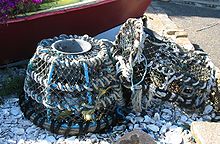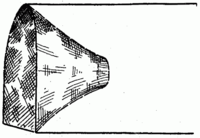- Lobster trap
-
For other uses, see Lobster trap (disambiguation).
Not to be confused with Lobster-tailed pot
 Lobster pots in Jersey
Lobster pots in Jersey
A lobster trap or lobster pot is a portable trap that traps lobsters or crayfish and is used in lobster fishing. A lobster trap can hold several lobsters. Lobster traps are constructed of wire and wood. An opening permits the lobster to enter a tunnel of netting. Pots are usually constructed in two parts, called the "chamber" or “kitchen”, where there is bait, and exits into the “parlour”, where it is trapped from escape. Lobster pots are usually dropped to the sea floor about a dozen at a time, and are marked by a buoy so they can be picked up later.
Contents
Description
The trap can consist of a wooden frame surrounded by a rope mesh. The majority of the newer traps found in the Northeast of the USA and the Canadian Maritimes consist of a plastic-coated metal frame. A piece of bait, often fish or chum, is placed inside the trap, and the traps are dropped onto the sea floor. A long rope is attached to each trap, at the end of which is a plastic or styrofoam buoy that bears the owner's license number. The entrances to the traps are designed to be one-way entrances only. The traps are checked every other day by the fisherman and rebaited if necessary. One study indicated that lobster traps are very inefficient and allow almost all lobsters to escape.[1]
History
The lobster trap was invented in 1808 by Ebenezer Thorndike of Swampscott, Massachusetts.[2] By 1810, the wooden lath trap is said to have originated in Cape Cod, Massachusetts. New England fishermen in the United States used it for years before American companies introduced it to the Canadian fishery through their Atlantic coast canneries.[3]
An 1899 report by the United States Fish Commission on the Lobster Fishery Of Maine, described the local "lath pots" used by Maine lobster fishers:[4]
The framework of the bottom consists of three strips of wood, either hemlock, spruce, or pine (the first mentioned being the most durable[cite] ), a little longer than the width of the pot, about 2¾ inches wide and 1 inch thick. In the ends of each of the outer strips a hole is bored to receive the ends of a small branch of pliable wood, which is bent into a regular semicircular curve. These hoops are made of branches of spruce or hemlock, or of hardwood saplings, such as maple, birch, or ash, generally retaining the bark. Three of these similar frames, straight below and curved above, constitute the framework of each pot, one to stand at each end and one in the center. The narrow strips of wood, in general ordinary house laths of spruce or pine, which form the covering, are nailed lengthwise to them, with interspaces between about equal to the width of the lathe. On the bottom the laths are sometimes nailed on the outside and sometimes on the inside of the cross pieces. The door is formed by three or four of the laths running the entire length near the top. The door is hinged on by means of small leather strips, and is fastened by a single wooden button in the center, or by two buttons, one at each end. The openings into the pot ... are two in number, one at each end, are generally knit of coarse twine and have a mesh between three-fourths of an inch and 1 inch square. They are funnel-shaped, with one side shorter than the other, and at the larger end have the same diameter as the framework. The smaller and inner end measures about 6 inches in diameter and is held open by means of a wire ring or wooden hoop. The funnels are fastened by the larger ends to the end frames of the pot, with the shorter side uppermost, so that when they are in place they lead obliquely upward into the pot instead of horizontally. The inner ends are secured in position by one or two cords extending to the center frame. The funnels are about 11 or 12 inches deep, and therefore extend about halfway to the center of the pot. They taper rapidly and form a strongly inclined plane, up which the lobsters must climb in their search for the bait. A two-strand manila twine is most commonly used for the funnels. Cotton is also used, but is more expensive and less durable.—John N. Cobb, The Lobster Fishery of MaineSee also
Notes
- ^ A lobster's life - US News and World Report
- ^ "How to Use a Lobster Trap". USA Today. http://traveltips.usatoday.com/use-lobster-trap-13914.html.
- ^ "History of Lobster Fishing and Processing". Pictou-Antigonish Regional Library. http://www.parl.ns.ca/lobster/history.htm.
- ^ The Lobster Fishery of Maine by John N. Cobb; Bulletin of the United States Fish Commission, Vol. 19, Pages 241-265, 1899; from Project Gutenberg
Fishing tackle Fish hook 
Fishing line - Monofilament
- Multifilament
- Braided
- Power pro
- Swivel
- Fishing knots
Fishing sinker Fishing rod Fishing bait Plastic bait - Soft plastic lure
- Plastic worm
- Deadsticking
- Texas rig
- Carolina rig
Fishing lures Bite indicators Apparel etc Fishing techniques Gathering - Gathering seafood by hand
- Clam digging
- Pearl diving
- Ama divers
- Abalone
- Scallops
- Noodling
- Trout tickling
- Trout binning
- Flounder tramping
Spears Lines - Hand-line fishing
- Longline fishing
- Trolling
- Dropline
- Trotline
- Jigging
- Jiggerpole
- Jug fishing
- Category:Fishing knots
Nets - Fishing net
- Hand net
- Cast net
- Lave net
- Gill net
- Drift net
- Surrounding net
- Seine net
- Tangle net
- Trawl net
- Chinese fishing net
- Lampuki net
- Glass floats
- Ghost nets
- Turtle excluder device
Traps - Fishing traps
- Fish wheel
- Fishing weir
- Fishing basket
- Eel buck
- Putcher fishing
- Corf
- Trabucco
- Lobster trap
- Almadraba
- Double-Heart of Stacked Stones
Other Fisheries and fishing topic areas Fisheries 
Fishing - Fisherman
- Artisan fishing
- Fishing villages
- Fishing vessels
- Fishing history
Industrial Recreational Techniques Tackle Locations - Fishing by country
- Fishing villages
- Fishing banks
- Fish ponds
- Marine habitats
- Index of fishing articles
- List of fishing topics by subject
- Fisheries glossary
Categories:- Fishing equipment
- True lobsters
Wikimedia Foundation. 2010.



